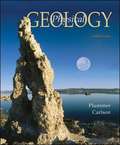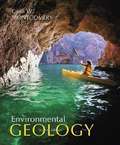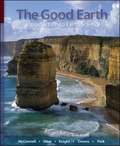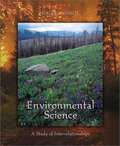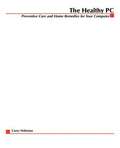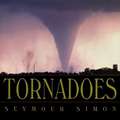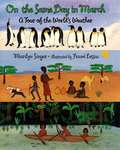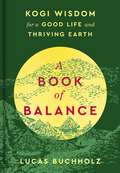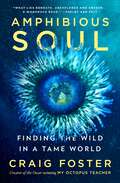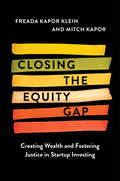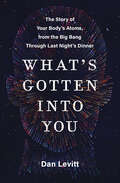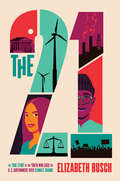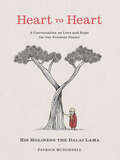- Table View
- List View
Physical Geology (12th Edition)
by Charles C. Plummer Diane H. CarlsonOne excellent reason to read this book is that it's tried and true. Since the book was published in 1979, over 1,000,000 students have read this text as an introduction to physical geology. Proportionately, geology instructors have relied on this text for over 5,000 courses to explain, illustrate, and exemplify basic geologic concepts to both majors and non-majors. Today, the 12th edition continues to provide contemporary perspectives that reflect current research, recent natural disasters, unmatched illustrations, and unparalleled learning aids. We have worked closely with contributors, reviewers, and our editors to publish the most accurate and current text possible.
Environmental Geology (Seventh Edition)
by Carla W. MontgomeryPresents the student with an overview of environmental geology. This book looks both at how the earth developed into its present condition. It helps provide the students with a useful foundation for discussing and evaluating specific environmental issues, as well as for developing ideas about how the problems should be solved.
The Good Earth
by David Mcconnell David Steer Catharine Knight Katharine Owens Lisa ParkThe Good Earth covers the primary topics included in other earth science texts. However, there are a few notable differences in its content compared to other textbooks. The Good Earth begins with an introduction (Chapter 1), then takes up the topic of astronomy (Chapters 2, 3), and moves on to solid earth (Chapters 4, 5, 6, 7, 8), and the processes (Chapters 9, 10, 11, 12), which overlap with the hydrosphere (Chapters 11, 12, 13), before dealing with the atmosphere (Chapters 14, 15, 16), and finishing with a wrap-up chapter on global change (Chapter 17) that incorporates elements of all the previous chapters. This text also includes interesting examples from recent events in relation to near-Earth asteroids, earthquakes, tsunamis, rockfalls, floods, and climate change.
Environmental Science: A Study of Interrelationships Eighth edition
by Eldon D. Enger Bradley F. SmithEnvironmental Science is an interdisciplinary field. Because environmental disharmonies occur as a result of the interaction between humans and the natural world, we must include both when seeking solutions to environmental problems.
The Healthy PC: Preventive Care and Home Remedies for Your Computer
by Robert J. Shimonski Carey HolzmanLearn routine maintenance as well as desktop basics, hard drive care and defragmentation, and plenty more to make your PC more efficient and keep it running smoothly. Learn software management, tame the Internet, secure your machine, deal with downloads, and much more.
Clouds (Let's Read and Find Out Science)
by Anne Rockwell Frané LessacDo you ever wake up and wonder what the weather will be? Instead of turning on the TV to find out, you can just look out your window at the clouds. How do you know what type of clouds can forecast a change of weather? Read and find out.
Volcanoes: Let's-Read-and-Find-Out Science
by Franklyn M. BranleyThis is a Stage 1 Let's-Read-and-Find-Out, which means the book explains simple science concepts for preschoolers and kindergarteners.
Earthquakes
by Franklyn M. BranleyRead and find out about one of nature's most mysterious forces--the earthquake. Some earthquakes are so small that you don't even feel them, while others can make even big buildings shake! Learn why earthquakes happen, where they are most likely to occur, and what to do if one happens near you.
Flash, Crash, Rumble, and Roll
by Franklyn M. BranleyExplains how and why a thunderstorm occurs and gives safety steps to follow when lightning is flashing.
Let's Go Rock Collecting (Let's-read-and-find-out Science #1)
by Roma GansDescribes the formation and characteristics of igneous, metamorphic, and sedimentary rocks and how to recognize and collect them
Down Comes The Rain (Let's-Read-And-Find-Out-Science)
by Franklyn M. BranleyAfter rain comes down, the sun comes out and dries the puddles. But the water isn't gone. The heat from the sun has turned it into water vapor-it has evaporated. Eventually, this moisture in the air condenses to form new clouds. Soon the rain will fall again. Read on to find out all the ups and downpours of the water cycle!
How Mountains Are Made
by Kathleen Weidner Zoehfeld James Graham HaleEven though Mount Everest measures 29,028 feet high, it may be growing about two inches a year. A mountain might be thousands of feet high, but it can still grow taller or shorter each year. Mountains are created when the huge plates that make up the earth's outer shell very slowly pull and push against one another. Read and find out about all the different kinds of mountains.
What Will the Weather Be?
by Lynda DewittWill it be warm or cold? Should we wear shorts or pants? Shoes or boots? Read and find out why the weather is so difficult to predict.
Feel The Wind (Let's-Read-and-Find-Out Science)
by Arthur DorrosHave you ever felt the wind tickle your face or heard it whistle through your window? Did you know that some wind travels faster than a car? <p><p> Air is always moving. We can't see air moving, though we can watch it push clouds across the sky, or shake the leaves of a tree. We call moving air the wind. In this enlarged edition, find out about the wind - what causes it, how it can be used to help us, and how it affects the weather. <p> Arthur Dorros shows you how to make your own weather vane, and in simple terms, with playful illustrations, he explains just what makes the wind that blows all around us.
What Makes Day and Night
by Franklyn M. Branley"What Makes Day and Night" goes through the cycle of the earth and its revolutions around the sun.
Tornadoes
by Seymour SimonDescribes the location, nature, development, measurement, and destructive effects of tornadoes, as well as how to stay out of danger from them.
On The Same Day In March: A Tour Of The World's Weather
by Marilyn Singer Frané LessacOn the same day in March... Polar bears ride on Artic ice. People in French cafes turn up their faces to the sun. Hailstones roll over Indian hillsides. Rain makes a river in Kenya. On the same day that it's icy cold in the Artic, it's foggy in Louisiana, sunny in Barbados, and blowing wild winds called willy-willies in Austrailia. In this poetic exploration of longitude and weather, with bright and detailed paintings of seventeen different places, Marilyn Singer and Frane Lessac show us what's happening from the poles to the equator-- all on the same day in March. <P> Top 10 Science Books for Children 2000 (Booklist) and Notable Children's Trade Books in the Field of Social Studies 2001, National Council for SS & Child. Book Council
A Book of Balance: Kogi Wisdom for a Good Life and Thriving Earth
by Lucas BuchholzWe all need help centering ourselves to serve ourselves and our world. In this small, beautiful book, the Kogi—a remote and ancient tribe in the mountains of Colombia--offer their learnings. They pose nine thought-provoking questions to help us live harmoniously with the earth and in turn find happiness and purpose in every moment.“Just as we are both sitting here and talking, this is how we can live well. All of this you will write in the book.”—Mama Jose Gabriel, a spiritual guide of the Kogi tribe, to author Lucas BuchholzFor centuries, the Kogi have lived in seclusion in Colombia’s remote Sierra Nevadas, known as “the heart of the world.” But in recent years, concerned by the environmental degradation they have experienced in their villages and forests, a few emissaries from the tribe emerged to bring an urgent and loving message to the West—advice on how to live in harmony with the earth.Buchholz was invited to their home to receive and transcribe this message. A Book of Balance takes us on a journey into a startlingly beautiful landscape and into a sacred space: the traditional fireside circle held regularly by the tribe. In this circle, members consider key questions essential to their community.In this slim volume of spiritual introspection, they ask us to share in their practice, posing nine questions that focus our minds and hearts on who we are, who we can become.Throughout we hear the words of the Kogi elders, wisdom that offers revelations, inspiration, and direction for our everyday lives.A beautiful book to own, to share with friends, and discuss in community.
Amphibious Soul: Finding the Wild in a Tame World
by Craig Foster“An important book that will transform how we think about being human. … that will inspire hope.”—Jane GoodallHow can we reclaim the soul-deepening wildness that grounds us and energizes us when so much of the modern world seems designed to tame us?In this thrilling memoir of a life spent exploring the most incredible places on Earth—from the Great African Seaforest to the crocodile lairs of the Okavango Delta—Craig Foster reveals how we can attend to the earthly beauty around us and deepen our love for all living things, whether we make our homes in the country, the city, or anywhere in between.Foster explores his struggles to remain present to life when a disconnection from nature and the demands of his professional life begin to deaden his senses. And his own reliance on nature’s rejuvenating spiritual power is put to the test when catastrophe strikes close to home.Foster’s lyrical, riveting Amphibious Soul draws on his decades of daily ocean dives, wisdom from Indigenous teachers, and leading-edge science.
Closing the Equity Gap: Creating Wealth and Fostering Justice in Startup Investing
by Freada Kapor Klein Mitchell KaporA social activist and an entrepreneur remake the future of investing and business, offering a win-win road map for creating wealth and addressing inequalities by investing in groundbreaking tech companies that defy assumptions from Silicon Valley to Wall Street.Companies backed by venture capital drive the U.S. economy, accounting for hundreds of billions of dollars in sales and profits. The problem is that most of the wealth created winds up enriching elites, while the businesses funded by venture capitalists widen economic inequality. Committed to doing things differently, tech venture capitalists Freada Kapor Klein and Mitch Kapor launched Kapor Capital to prove that investing in gap-closing startups—companies whose services or products close opportunity gaps for both communities of color and low-income communities—is good business. Over the past decade, they’ve broadened the definition of success to include profits and accountability for the impacts a business has on employees, communities, and the planet, helping to launch close to two hundred companies engaged in achieving social and economic justice while showing remarkable growth, with many valued in the hundreds of millions or billions of dollars.Like every VC firm, Kapor Capital has experienced high-profile blowups and total losses. But its investing principles have created a stunning new ecosystem of Black and Latinx entrepreneurs, CEOs, and investors, all devising innovative, effective solutions to address the most pernicious problems afflicting many of America’s poorest communities. In Closing the Equity Gap, Freada and Mitch share their core belief that all companies must make a positive impact and that the obstacles entrepreneurs overcome in life are a far better predictor of long-term success than the schools they attend or investment dollars they raise from friends and family. Using stories behind some of the most remarkable companies ever launched, they show that the standard investment model doesn’t work, how it can be fixed, and what the future could look like if more investors joined them.
What's Gotten Into You: The Story of Your Body's Atoms, from the Big Bang Through Last Night's Dinner
by Dan LevittFor readers of Bill Bryson, Neil deGrasse Tyson and Siddhartha Mukherjee, a wondrous, wildly ambitious, and vastly entertaining work of popular science that tells the awe-inspiring story of the elements that make up the human body, and how these building blocks of life travelled billions of miles and across billions of years to make us who we are.Every one of us contains a billion times more atoms than all the grains of sand in the earth’s deserts. If you weigh 150 pounds, you’ve got enough carbon to make 25 pounds of charcoal, enough salt to fill a saltshaker, enough chlorine to disinfect several backyard swimming pools, and enough iron to forge a 3-inch nail. But how did these elements combine to make us human? All matter—everything around us and within us—has an ultimate birthday: the day the universe was born. This informative, eye-opening, and eminently readable book is the story of our atoms’ long strange journey from the Big Bang to the creation of stars, through the assembly of Planet Earth, and the formation of life as we know it. It’s also the story of the scientists who made groundbreaking discoveries and unearthed extraordinary insights into the composition of life. Behind their unexpected findings were investigations marked by fierce rivalries, obsession, heartbreak, flashes of insight, and flukes of blind luck. Ultimately they’ve helped us understand the mystery of our existence: how a quadrillion atoms made of particles from the Big Bang now animate each of our cells.Shaped by the curious mind and bold vision of science and history documentarian Dan Levitt, this wondrous book is no less than the story of life itself.
Fossils Tell of Long Ago (Let's-Read-and-Find-Out Science 2)
by AlikiWhat is a fossil?Sometimes it's the imprint of an ancient leaf in a rock. Sometimes it's a woolly mammoth, frozen for thousands of years in the icy ground. Sometimes it's the skeleton of a stegosaurus that has turned to stone.A fossil is anything that has been preserved, one way or another, that tells about life on Earth. But you can make a fossil, too—something to be discovered a million years from now—and this book will tell you how.
Flash, Crash, Rumble, and Roll (Let's-Read-and-Find-Out Science 2)
by Dr. Franklyn M. BranleyRead and find out about what causes the flash, crash, rumble, and roll of thunderstorms in this colorfully illustrated nonfiction picture book.Did you know that lightning bolts can be over a mile long? Or that they may come from clouds that are ten miles high? Storms can be scary, but not if you know what causes them. Before the next thunderstorm, grab this book by the expert science team Franklyn Branley and True Kelley and learn all about thunderstorms.This is a clear and appealing science book for early elementary age kids, both at home and in the classroom. It's a Level 2 Let's-Read-and-Find-Out, which means the book explores more challenging concepts for children in the primary grades. The 100+ titles in this leading nonfiction series are:hands-on and visualacclaimed and trustedgreat for classroomsTop 10 reasons to love LRFOs:Entertain and educate at the same timeHave appealing, child-centered topicsDevelopmentally appropriate for emerging readersFocused; answering questions instead of using survey approachEmploy engaging picture book quality illustrationsUse simple charts and graphics to improve visual literacy skillsFeature hands-on activities to engage young scientistsMeet national science education standardsWritten/illustrated by award-winning authors/illustrators & vetted by an expert in the fieldOver 130 titles in print, meeting a wide range of kids' scientific interestsBooks in this series support the Common Core Learning Standards, Next Generation Science Standards, and the Science, Technology, Engineering, and Math (STEM) standards. Let's-Read-and-Find-Out is the winner of the American Association for the Advancement of Science/Subaru Science Books & Films Prize for Outstanding Science Series.
The Twenty-One: The True Story of the Youth Who Sued the U.S. Government Over Climate Change
by Elizabeth RuschCompelling and timely, award-winning author Elizabeth Rusch’s The Twenty-One tells the gripping inside story of the ongoing landmark federal climate change lawsuit, Juliana vs. United States of America. The Twenty-One is for readers of Christina Soontornvat’s All Thirteen, fans of Steve Sheinkin’s books, and anyone interested in the environment and climate change, as well as youth activism, politics and government, and the law. From severe flooding in Louisiana to wildfires in the Pacific Northwest to melting permafrost in Alaska, catastrophic climate events are occurring more frequently—and severely—than ever. And these events are having a direct impact on the lives (and futures) of young people and their families. In the ongoing landmark case Juliana vs. United States, twenty-one young plaintiffs claim that the government’s support of the fossil-fuel industry is actively contributing to climate change, and that all citizens have a constitutional right to a stable climate—especially children and young adults, because they cannot vote and will inherit the problems of the future.Elizabeth Rusch’s The Twenty-One is a gripping legal and environmental thriller that tells the story of twenty-one young people and their ongoing case against the U.S. government for denying their constitutional right to life and liberty. A rich, informative, and multifaceted read, The Twenty-One stars the young plaintiffs and their attorneys; illuminates the workings of the United States’s judicial system and the relationship between government, citizens’ rights, and the environment; and asks readers to think deeply about the future of our planet. Features extensive backmatter, including a timeline, glossary, call to action, additional resources, and photographs.
Heart to Heart: A Conversation on Love and Hope for Our Precious Planet
by Dalai Lama Patrick McDonnellFrom His Holiness the Dalai Lama and Mutt’s cartoonist and award-winning author Patrick McDonnell comes a powerful and timely gem of a book on how to heal our relationship with the planet and each other.At the Dalai Lama’s residence in Dharamsala, India, an unusual visitor has arrived. His Holiness interrupts his morning meditation to greet a troubled Giant Panda who has travelled many miles to see him. Welcoming him as a friend, His Holiness invites the Panda on a walk through a cedar forest. There in the shadow of the Himalayas, surrounded by beauty, they discuss matters great and small . . .With a galvanizing message about the future of our planet—text by His Holiness accompanied by McDonnell’s masterful illustrations—Heart to Heart calls for a Compassionate Revolution, reminding us that “we are indeed all members of a single family, sharing one little house.” Told with whimsy, wisdom, and warmth, this beautiful book is deceptively simple in its approach and all the more powerful for it, as it elegantly and decisively conveys a message of joy, hope and change.“There are only two days in the year that nothing can be done. One is called Yesterday, and one is called Tomorrow.”
